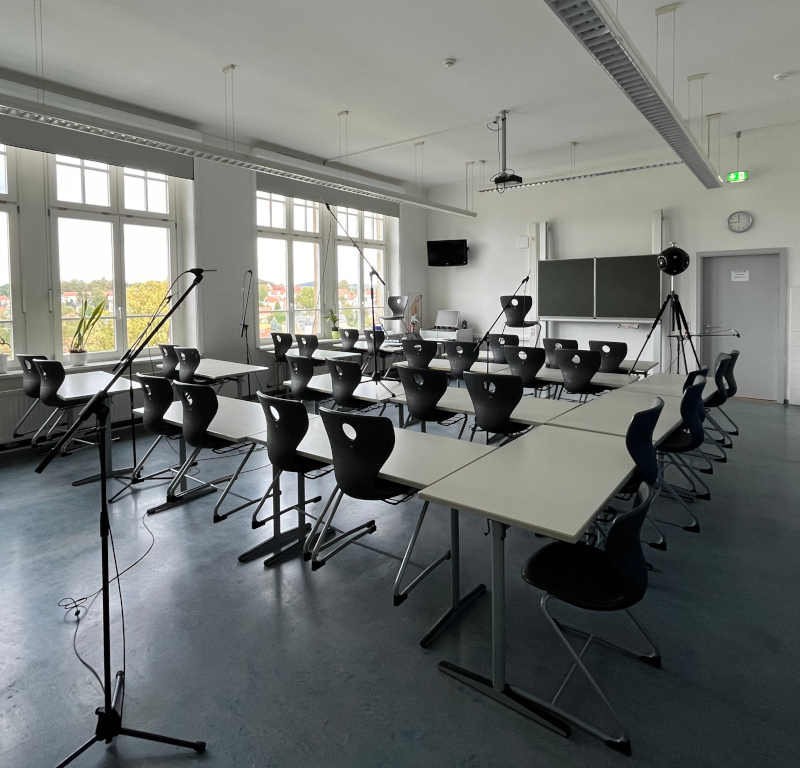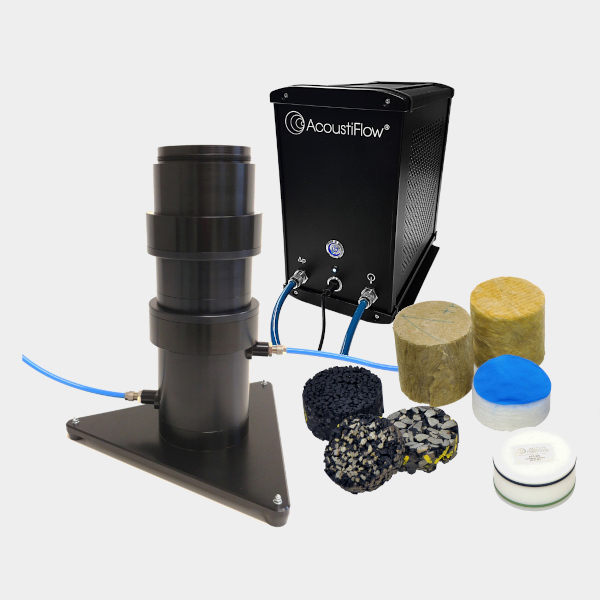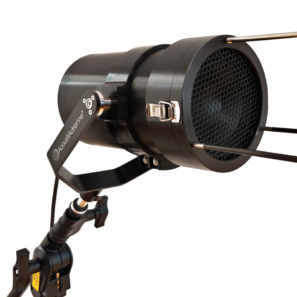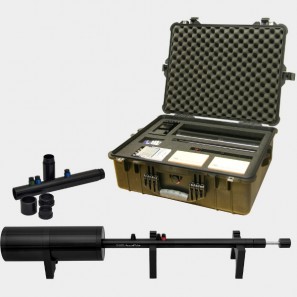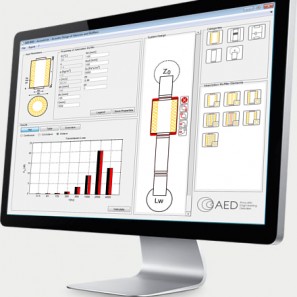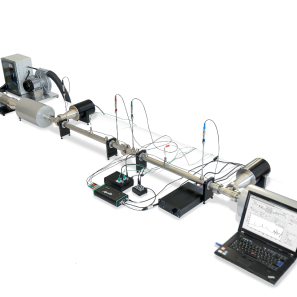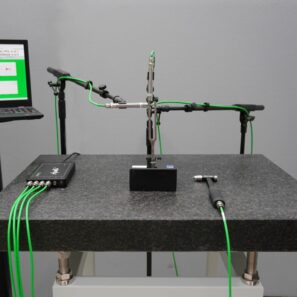Principle of measurements of room acoustics and building acoustics
A large number of test methods of room acoustics and building acoustics are based on the targeted generation of narrow or broadband sounds by test sound sources in conjunction with the metrological recording and targeted analysis of the sound fields generated in the transmitting and/or receiving room.
For this purpose, during the measurement, standardized high-power test sound sources for airborne sound (e.g. omnidirectional dodecahedron loudspeakers, directional mouth sound source) or structure-borne sound (e.g. impact hammer (periodic impulse-like force application), falling steel ball (single impulse-like force application)) are usually applied.
For acquisition, measuring microphones (free-field microphones, diffuse-field microphones, pressure microphones) are generally applied. Their analog voltage signals are digitized via a data acquisition unit and then made available to a software for signal analysis and processing.
Parameters of room acoustics
The measuring system for room acoustics and building acoustics allows the measurement of, among others, the following, mostly frequency-dependent parameters and associated acoustic quantities for room acoustics:
- sound pressure level at individual microphones in the transmitting room and calculated energetic mean values in conjunction with various time and frequency weightings, e.g. LAF, LAeq, LCF, LCeq
- reverberation time of rooms, e.g. RT60, RT30, RT20, RT15, EDT) according to DIN EN ISO 3382-2
- equivalent sound absorbing area A of rooms
- sound absorption coefficient alpha of building elements for diffuse sound incidence (differential measurement)
- speech intelligibility index, e.g. C50, C80
- speech transmission index STI
Parameters of building acoustics
The measuring system for room acoustics and building acoustics allows the measurement of, among others, the following, mostly frequency-dependent parameters and associated acoustic quantities for building acoustics:
- sound pressure level at individual microphones in the transmitting room and calculated energetic mean values in conjunction with various time and frequency weightings, e.g. LAF, LAeq, LCF, LCeq
- reverberation time of rooms, e.g. RT60, RT30, RT20, RT15, EDT) according to DIN EN ISO 3382-2
- sound reduction index (sound insulation) Rw and impact noise level Lnw of separating building elements (e.g. walls, ceilings, facades) according to DIN EN ISO 16283-1 to DIN EN ISO 16283-3, DIN EN ISO 10140-2 and DIN EN ISO 10140-3, DIN EN ISO 717-1 and DIN EN ISO 717-2
Components of measuring system for room acoustics and building acoustics
The measuring system for room acoustics and building acoustics consists of the following components, among others:
Technical Data (Excerpt)
Testing noise source airborne sound
- omnidirectional, powerful dodecahedron loudspeaker
- power amplifier with integrated noise generator for white and pink noise and radio remote control
Testing noise source structure-borne sound
- tapping machine incl. transport bag, battery set and charger
Measuring microphones and accessories
- measuring microphone 1/2“, class 1
- IEPE measuring microphone 1/2″ + preamplifier
- frequency range: 3,5 Hz – 20 kHz
- dynamic range: 15 dB(A)-135 dB(A)
- BNC connector
- TEDS
- measuring microphone 1/4“, class 1
- IEPE measuring microphone 1/4″
- 4 mA IEPE/ICP required
- UNF10-32/BNC adapter
- microphone calibrator, class 1
- for measuring microphones 1/2“
- PTB approval, class 1
- 1 kHz
- switchable between 94 dB / 114 dB
- adapter for measuring microphones 1/4“ available
- other available accessories
- microphone fitting
- tripod for microphones
- connecting cable microphone-data acquisition unit
- windshield for microphones
- et al.
Modular, scalable multi-channel data acquisition unit
- NoisePAD™
- handheld, mobile 4-channel sound and vibration analyzer (incl. PC)
- rugged industrial 8-inch tablet (Windows 10) equipped with Intel™ ATOM Cherrytrail processor and DSP-based analyzer
- new and improved software interface of analysis software SAMURAI™ 3.0 (adapted for touch operation of the NoisePAD™)
- internal 128 GB SSD enables recording of time and real-time analysis data at full bandwidth in all channels simultaneously, even over several days
- 4 measurement channels, powerful 24-bit A/D converter, IEPE power supply, frequency range up to 20 kHz
- 2 additional tacho/trigger channels for recording speeds and for external control of the measuring device
- 1 signal generator output for outputting noise or sweep signals, for example
- IP54, -20 °C…+50 °C, meets MIL810 standard, all connections protected against water and dust with rubber seals
- safe and reliable connection of ICP/IPEE sensors via LEMO-CAMAC connectors
- very low power consumption, battery life up to 12 hours
- in preparation for application for PTB type approval
- available accessories: docking station, carrying case, VDC adapter set, tripod holder
- Apollo Box
- flexible and cost-effective 2- or 4-channel data acquisition system with USB interface (requires additional PC)
- 2 or 4 measuring channels selectable with variants with BNC or LEMO7 connectors, powerful 24-bit A/D converter, IEPE power supply, and/or phantom power, frequency range up to 80 kHz
- 8 low-sampled channels
- 2 tacho or trigger channels
- 1 output channel for the output of test sounds
- possible coupling of up to 4 modules via synchronization cable (synchronization with Soundbook MK2 Expander also possible; see measuring system for sound power)
- Apollo Box lt
- cost-effective 2-/4-/8- or 16-channel sound and vibration analyzer in a robust, high-quality aluminum housing with USB interface (requires additional PC)
- 2, 4, 8, or 16 measurement channels, powerful 24-bit A/D converter, IEPE power supply, frequency range up to 20 kHz
- additional trigger/tacho and output channels, frequency range up to 20 kHz
- BNC/LEMO/NIM CAMAC connectors
- particularly low power consumption enables operation with a tablet PC
- multiple Apollo lt modules can be synchronized with each other; sample rate can be individually adjusted for each channel
Multifunctional data acquisition and analysis software Samurai
- module Sound level meter
- module Octave and third octave band filters
- module Reverberaton time to determine the reverberation time via
- impulse
- noise switched off and
- sinus sweep
- module Multi-generator for generating different test signals
- module Room acoustics with impulse response method for determining
- speech intelligibility index C50 and C80
- speech transmission index STI and STIPA
- module Building acoustics to determine
- airborne sound insulation and
- impact noise level
nach
- DIN EN ISO 16283-1 to DIN EN ISO 16283-3
- DIN EN ISO 10140-2 and DIN EN ISO 10140-3
- DIN EN ISO 3382-2
- DIN EN ISO 717-1 and DIN EN ISO 717-2
- et al.
Training and Evaluation
The Gesellschaft für Akustikforschung Dresden mbH offers you and your employees training in the handling and operation of the measurement components and the corresponding analysis software and creates defined evaluation scripts upon request (e.g. in xlsx format).
Design of acoustic test benches according to standards, implementation of software solutions
Upon customer request, we support you in the design of acoustic test benches (e.g. acceptance tests for building elements) according to specific standards and/or the implementation of customized software solutions for you.
Calibration
On demand, we subject the input channels of the data acquisition unit to calibration by a DAkkS-certified body.
